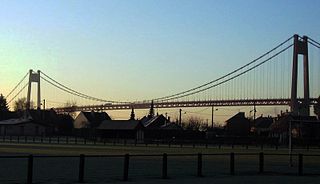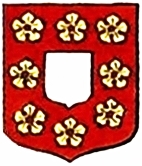
Bonneville-sur-Touques is a commune in the Calvados department in the Normandy region in northwestern France, located four kilometres from the urban agglomeration Deauville-Trouville. The commune is principally famous for its 11th century castle, which protected the nearby supply port of Touques. The population is 347 (2017).

Clécy is a commune in the Calvados department in the Normandy region in northwestern France.

Crépon is a commune in the Calvados department in the Normandy region in northwestern France.

The Pays de Caux is an area in Normandy occupying the greater part of the French département of Seine Maritime in Normandy. It is a chalk plateau to the north of the Seine Estuary and extending to the cliffs on the English Channel coast; its coastline is known as the Côte d'Albâtre. In the east, it borders on the Pays de Bray where the strata below the chalk show through.

Bolbec is a commune in the Seine-Maritime department in the Normandy region in northern France. Its inhabitants are called Bolbécais or Bolbécaises.

The architecture of Normandy spans a thousand years.

Tancarville is a commune in the Seine-Maritime department in the Normandy region of northern France.

Bertangles is a commune in the Somme department in Hauts-de-France in northern France.

Haramont is a commune in the Aisne department in Hauts-de-France in northern France.

Genlis is a commune in the Côte-d'Or department in eastern France. The 20th-century archaeologist Jean Charbonneaux (1895–1969) was born in Genlis.

Sioniac is a commune in the Corrèze department of Nouvelle-Aquitaine region in central France.

Épône is a commune in the Yvelines department in the Île-de-France region in north-central France. It is situated on the left bank of the River Seine 40 kilometres (25 mi) west of Paris. Together with Mézières-sur-Seine and La Falaise, it forms a settlement of around 10,000 inhabitants. Its inhabitants are known as Épônois.

The Château de Gerbéviller is a chateau in the small community of Gerbéviller in Lorraine, France. The site has been occupied since at least the 12th century. The present buildings date from the 17th to 19th centuries, and include the chateau, a theater, a chapel, a pavilion and a unique water nymphaeum. The chateau and chapel were badly damaged during World War I, but have been repaired. They have been protected under various designations since 1945, and since February 1996 have had an overall designation as a historical monument. The park of the chateau with its views over the valley of Mortagne has been a classified natural site since 1999.

The Château de Keriolet is a castle built in the 19th century in Concarneau (France).

The Château du duc d'Épernon is a château, built on the site of a medieval castle located in Fontenay-Trésigny, in the Brie region of France, 43 km (27 mi) southeast of Paris. It stands alongside the Bréon stream and next to the Church of Saint-Martin, in the heart of a once walled old town, the history of which is closely linked to the history of the château. The castellans were lords of Fontenay-en-Brie during the Old Regime.

Argentat-sur-Dordogne is a commune in the department of Corrèze, south-central France. The municipality was established on 1 January 2017 by merger of the former communes of Argentat and Saint-Bazile-de-la-Roche.

The "family of Tancarville" was of Norman stock, of likely Scandinavian descent, originating in the Pays de Caux, from that of the Viking Tancredus, companion of Rollo, in the conquest of northern France. Tancreds' progeny remaining closely tied to the royal family, becoming the hereditary Chamberlains of Normandie and of England, as well as many other crown offices. The family was known as being, "in the highest ranks of the Anglo-Norman aristocracy, the lords of Tancarville".

















